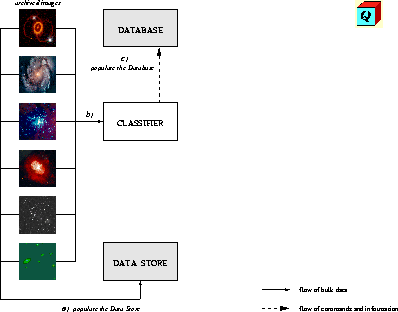 |
Next: Integrating the ZGSC and PPM at the Galileo Telescope for On-line Control of Instrumentation
Up: Archives and Information Services
Previous: An Archival System for Observational Data Obtained at the
Okayama and Kiso Observatories. III
Table of Contents -- Index -- PS reprint -- PDF reprint
F. Pasian and R. Smareglia
Osservatorio Astronomico di Trieste, 34131 Trieste, Italy
Email: pasian@ts.astro.it
With the exponential expansion of information systems, accessing data archives plays a role which is becoming increasingly important for the dissemination of scientific knowledge at all levels. The need is felt to make access to data archives simpler for the community of users at large. Queries on the data, regardless of their complexity, should be easier to specify, more intuitive, simplified with respect to those currently in use. In other words, users should be able to express queries in an intuitive way, without knowing the detailed physical structure and naming of data. Content-based information retrieval is receiving increasing attention from scientists, e.g., see Ardizzone et al. (1996), and Lesteven et al. (1996).
This project aims to allow access to data archives by means of a query-by-example mechanism: the user should be put in a position to provide a ``user object", a template of what he/she wishes to retrieve from the archive. The system managing the archive should provide the user with archived data resembling the template on the basis of some desired characteristic, and with some ``resemblance parameter". Data understanding (classification and recognition of descriptive features) is deemed to be an essential step of the query-by-example mechanism.
The objective of this project is to integrate database, mass storage, classification - feature recognition, and networking aspects into a unique system allowing a ``query-by-example" approach to the retrieval of data from remotely-accessible large image archives exploiting the algorithms up to their performance limits.
The basic idea, from the user's point of view, is to be able to submit a query to a remote archive in the form of an image (2-D or 1-D), telling the system: ``get me all the images/plots in the archive looking like this one, or having this specific feature". The basic user query would therefore simply be the submission of an image, either previously extracted from the very same archive, or owned by the user, or built via a modelling software. This operation must be feasible while connected remotely to the archive.
Several problems have been already identified. In the ``global" approach to the query-by-example mechanism, the various characteristics of images have the same weight. Difficulties here include coping with different image resolutions, being able to search for images having a specific feature in them by just submitting a small image template containing the feature itself, building models compatible with the archived images, etc. A more sophisticated approach would be to add a level of interaction with the user, allowing him/her to know which are the features of the images the system is able to recognize, and allow a choice of the features to be searched for.
A system called QUBE is currently being designed to support the QUery-By-Example paradigm in accessing astronomical data archives. A preliminary list of features is as follows:
The QUBE system is composed of:
The following operational scenario is envisaged, and is represented graphically in Figures 1 and 2, respectively:
The authors are grateful to H.M.Adorf, O.Yu.Malkov, J.D.Ponz and M.Pucillo for having discussions about the concepts of querying image archives by example. The images used for the figures in this paper are thumbnails of Hubble Space Telescope PR images.
Ardizzone, E., Di Gesù, V., & Maccarone, M. C. 1996, in Strategies and Techniques of Information in Astronomy, Vistas in Astronomy, 40, 401
Lesteven, S., Poinçot, P., & Murtagh, F. 1996, in Strategies and Techniques of Information in Astronomy, Vistas in Astronomy, 40, 395
Pasian, F., Smareglia, R., Hantzios, P., Dapergolas, A., & Bellas-Velidis, I. 1997, in: Wide-Field Spectroscopy, E.Kontizas, M.Kontizas, D.H.Morgan, G. Vettolani eds., Kluwer Academic Publishers, 103
Next: Integrating the ZGSC and PPM at the Galileo Telescope for On-line Control of Instrumentation
Up: Archives and Information Services
Previous: An Archival System for Observational Data Obtained at the
Okayama and Kiso Observatories. III
Table of Contents -- Index -- PS reprint -- PDF reprint